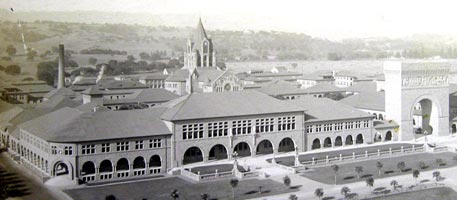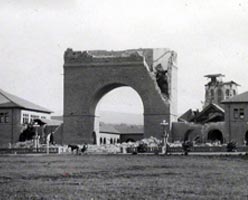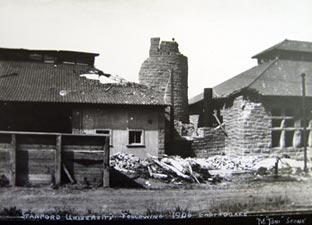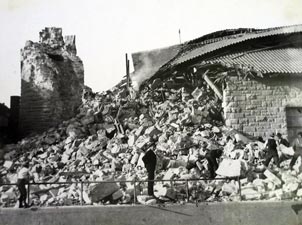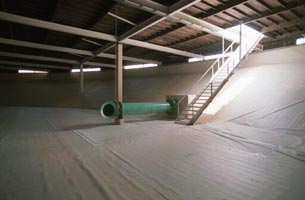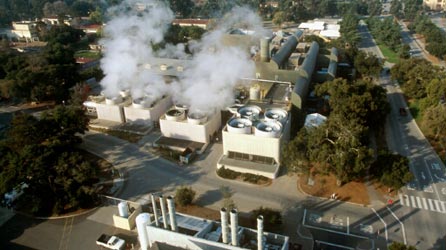|
|
||||||||||
 |
|
|
|
|||||||
|
|
||||||||||
|
|
|
|
|
|
|
|
|
|||
|
|
|
|
|
|
|
|
|
|
|
|
Walking Tour
| << Previous Stop |
 |
|||||||||
|
With more than 46 miles of roads, a 49-megawatt power plant, three dams and lakes, 100 miles of water mains, a central heating and cooling plant, and a high-voltage distribution system, Stanford is a self-sustaining community. On a campus that consists of 678 major buildings (12.6 million square feet) on 8,180 acres of land, emergency management is no simple task. Although the Loma Prieta earthquake in 1989 damaged 200 buildings and caused 22 minor hazardous materials incidents, it resulted in relatively little interruption compared to the 1906 quake and suspended University operations for only one day. The disruption was enough, however, to encourage Stanford to examine ways to reduce future losses of time and productivity as a result of post-earthquake confusion. “Our campus has come a long way in a short time, and our seismic safety programs are models for other universities, if not cities,” Roni Gordon, then Manager of Emergency Preparedness Planning, said ten years later in 1999. Stanford’s current emergency management program encompasses four phases, including mitigation, preparedness, response, and recovery. This program continues to evolve and improve, but, as Gordon said, “earthquakes are a normal, recurring phenomenon in this part of the world, and we will be challenged by them again.” Emergency Response and Life Safety in 1906 Figure 1: The Boiler House, designed by Shepley, Rutan, and Coolidge, with Charles Hodges 1887-1891, provided the campus with electric light and steam heat. Its chimney is visible in images of the Quad prior to 1906 At a time when earthquakes were unfamiliar and poorly understood, planning consisted mostly of experimenting with new building materials (see Site 1: Cantor Center) and remaining poised to respond in the case of a disaster. In addition to the death of sophomore Junius Hanna (see Site 6: Encina Hall), one courageous and dedicated worker was killed on campus by the 1906 earthquake.
At the Boiler House, the great chimney that towered high above the surrounding roofs collapsed and buried the night fireman, Otto Gerdes, who had remained at his post to turn off the electric power. The fall of this chimney killed Gerdes and demolished the broiler room and adjoining building (Figures 1-4). Edith R. Mirrielees, an undergraduate at the time, later explained, “The employee on duty at the powerhouse ran like the others at the first earth movement, then calling to the watchman, ‘They’ll all be on fire,’ ran back to throw the switch. The falling chimney caught him on his way out.” As a staff member committed to the livelihood of the University, Gerdes sacrificed himself not only to save the people present on campus that day but to ensure the survival of the young institution that most likely would not have recovered so brilliantly if fire had compounded the devastation that it would already face.
Life safety continues to be the highest priority in emergency preparedness and response. Having experienced only two deaths and relatively few injuries, the Stanford community barely paused to mourn its own destruction in 1906 before looking outward to the people who had been hit even harder in the city of San Francisco. According to Sandstone and Tile, published by the Stanford Historical Society, “A mass meeting had been held on one of the campus lawns. Volunteers were called for to help with the homeless, the sick and wounded of San Francisco. Many—students, faculty, and staff—responded, and in the excitement forgot their own troubles.” Some students served as guards to protect resources from rumored looters, others collected supplies for the Red Cross, and many walked up the train tracks to work at “Camp Stanford” and various relief stations throughout the city. Within two weeks, most volunteers returned to their families or summer jobs, but some stayed all summer. Loma Prieta Earthquake Shakes Stanford to Action After the 1989 Loma Prieta earthquake, Stanford was not affected operationally and was down for only one day. Just as it triggered evaluation of seismic stability, Loma Prieta also drew increased attention to the importance of organizational preparations in the event of a more severe quake. Emergency preparedness and planning were carried out prior to 1989 by the Police Department and the Director of Public Safety. There was a flurry of activity after the quake, and a committee on emergency preparedness was assembled. In the following year, the Earthquake Risk Management Commission reviewed the implementation of the existing Emergency Operations Plan and Stanford’s overall response to meeting the emergencies of the 1989 quake. The commission concluded that the response was effective and that the Emergency Operations Plan was a sound approach that merely needed adjustments to address the weak areas had been identified. Some specific improvements were made immediately:
It was well recognized that emergency planning would need more full time coordination, but interest waned over time until 1994 when the Northridge earthquake again brought the issue to the forefront. Ultimately, emergency planning leadership was moved to Stanford’s Department of Environmental Health & Safety in 1996. The current state of emergency planning finds its roots in this move, says Larry Gibbs, Associate Vice Provost of Environmental Health and Safety. Stanford’s Collegial Approach to Disaster Preparedness Unlike a commercial organization, Stanford’s approach to emergency preparedness is much less vertical. Higher education is by nature horizontal in structure, so Stanford exploits this arrangement through a “collegial” approach to emergency preparedness within a defined framework. This approach includes a Campus Emergency Plan, Cabinet Emergency Planning Guidelines, and Department Emergency Planning Guidelines, which respectively narrow in focus. Each department is given a template and appropriate support but is responsible for creating its own plan for preparedness. As early as 1990, this type of local planning was emphasized as critical to the success of the overall scheme. In his letter instructing the Deans and Vice Presidents in charge of making sure that these plans would be created, Marvin Herrington, Director of Public Safety at the time, emphasized, “The plan does not have to be complicated. When people are under great stress, a clear, concise plan will be remembered and used to respond to the emergency if it has been explained and exercised.” Other significant program improvements that define today’s emergency preparedness in comparison with what was in place before Loma Prieta include: 1) the establishment of an on-call team of 25 engineering firms for post-quake response, 2) the training of 400 Stanford staff members to make preliminary assessments of building exteriors (BATs- Building Assessment Teams), 3) the audit and improvement of power and utilities, 4) the improvement of emergency communication systems, and 5) the revision of safety plans to include the entire campus. Emergency preparedness today is also part of the Residential Education program, and students receive informational materials during orientation. In the “collegial” spirit of the plan, students are encouraged to inform their Resident Assistants if they have special skills that can be helpful in emergencies. Emergency plans at Stanford are generic, or “all hazard,” which makes them more efficient. According to Gibbs, Stanford’s plan is designed to provide a 36-72 hour window of self-sufficiency without regional resources. The Stanford Hospital is managed separately, so Stanford University also has medical response capability for some level of self-sufficiency. In the aftermath of an earthquake, distribution networks function through the Emergency Operations Center, located at the Faculty Club. The campus radio station KZSU and an emergency web site provide communications. Large gathering places like gymnasiums can function as alternatives for housing during building inspection, but tents stored off campus are also on call. Combined with mitigation efforts implemented by Stanford’s seismic retrofit program, its emergency management program makes Stanford, according to Gibbs, a very safe campus. There is always room for improvement, however, as highlighted by the Stanford Daily editorial staff in February 2006: “[W]hile there have been many infrastructural changes, there is a general lack of awareness among the student body when it comes to earthquake preparedness. Students caught in Memorial Church during an earthquake might be alarmed by the fact that the church was severely damaged during the past two. Should they dive under the pews or run out to the Quad? Similarly, falling palm trees and fast-moving traffic could create extraordinary hazards for students strolling down Palm Drive in the midst of a natural disaster.” Redundancy Protects Stanford’s Lifelines Lifeline systems are a serious concern in natural disasters, and Stanford has prepared itself for earthquakes through a set of redundant systems. A preliminary assessment of Stanford’s essential utilities and their vulnerability to a major earthquake was completed after 1989. These utilities are Stanford’s lifelines to the outside world as well as the campus’s essential life support systems. The lifelines in order of priority are water, telecommunications, electricity, steam, sanitary sewer and storm drain systems, and chilled water. After the Loma Prieta Earthquake, the Utilities Division of Stanford’s Facilities Operations developed and implemented design standards for new construction, undertook essential retrofit projects, and implemented contingency planning and training for earthquake response distributed around campus.
Figure 5: Stanford’s current water system is divided into three pressure zones, as shown in the domestic water system map. The San Juan Reservoir, constructed in 1901, was the main reservoir for the Stanford campus in 1906 and survived with little damage. In 1989, however, it was cracked and has since been taken out of service. The crack was small—it went unnoticed for three days—so water service continued without interruption, except to one building whose mains had been broken. All of the dams supporting Stanford’s water service survived without damage. A 2 million gallon reservoir built in the 1960s continued to provide water to the campus after the San Juan Reservoir was taken out of service. A new 6 million gallon reservoir (known as Reservoir 2) was also constructed in 2000. Like most of the region, Stanford’s water today is provided by the Hetch Hetchy system, a considerably reliable source since Stanford is uniquely connected by two sets of pipelines. However, in the case of an emergency in which this primary source is no longer available, Stanford’s drinking and firefighting needs could be temporarily satisfied by its current reservoir system located in the foothills (Figures 5-7). These reservoirs primarily rely on gravity to feed into the campus, so they could function even in the absence of power for their pumps. As a third backup, Stanford also has access to wells throughout campus, which were built early in its history to supply the community with water.
Supported by this redundancy, Stanford’s water supply is secure even in the face of a serious disaster. Of next concern is the distribution system, which could be disrupted by smaller breaks after earthquakes. “What happens with some of the pipes we have [is that after] the little shakes and things, even small ones, the leaks show up later. What happens is the bedding—the way the pipe is buried—shifts […] and two months later, two years later, you have things break,” a representative from the Stanford University Utilities Division explains. Breaks usually occur at the weakest point along a pipeline, and when that area is fixed, another area becomes weakest, causing additional breaks. Even in the case of breaks that occur immediately after a quake, the campus is not likely to be significantly impacted because the University’s domestic water system is divided into three separate pressure zones. The pipelines all interconnect, so small areas where pipes have broken can be isolated by closing valves in order to continue to supply the rest of the campus. Figure 8: Stanford’s Cardinal Cogeneration plant produces steam, chilled water, and electrical power. Cardinal Cogen is backed up by PG&E as well as approximately 100 emergency generators, which reduces the risk of losing important research due to a severe earthquake Stanford’s power system is similarly protected by triple redundancy. The on-campus cogeneration plant, Cardinal Cogen, produces all of the energy the campus needs (heating, cooling, and electricity), plus an extra 25 megawatts at peak that is returned to the grid for public consumption (Figure 8). During emergencies, this system is first backed up by PG&E and second by approximately 100 emergency generators that would keep the most critical buildings in operation. See an image gallery of the campus
|
||||||||
| << Previous Stop |
